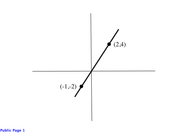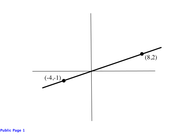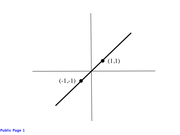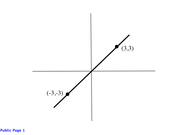Hello,
Can you please assist with this question? This is from MGMAT:
OA: D
Thanks for your help.
If line L has a positive slope, what is the x-intercept of L
This topic has expert replies
-
gmattesttaker2
- Legendary Member
- Posts: 641
- Joined: Tue Feb 14, 2012 3:52 pm
- Thanked: 11 times
- Followed by:8 members
- GMATGuruNY
- GMAT Instructor
- Posts: 15539
- Joined: Tue May 25, 2010 12:04 pm
- Location: New York, NY
- Thanked: 13060 times
- Followed by:1906 members
- GMAT Score:790
Many slope questions can be solved efficiently by DRAWING.If line L in the xy-coordinate plane has a positive slope, what is the x-intercept of L ?
(1) There are different points (a, b) and (c, d) on line L such that ad = bc.
(2) There are constants m and n such that the points (m, n) and (-m, -n) are both on line L
Statement 1: There are different points (a, b) and (c, d) on line L such that ad = bc.
Case 1: a=-1, d=4, b=-2, c=2
Here, line L contains (a,b) = (-1,-2) and (c,d) = (2,4):

Since line L passes through the origin, its x-intercept is 0.
Case 2: a=-4, d=2, b=-1, c=8
Here, line L contains (a,b) = (-4,-1) and (c,d) = (8,2):

Since line L passes through the origin, its x-intercept is 0.
The two random cases above illustrate that -- when ad=bc -- line L must pass through the origin and thus will have an x-intercept of 0.
SUFFICIENT.
Statement 2: There are constants m and n such that the points (m, n) and (-m, -n) are both on line L
Case 3: m=1 and n=1
Here, line L contains (m,n) = (1,1) and (-m,-n) = (-1,-1):

Since line L passes through the origin, its x-intercept is 0.
Case 4: m=-3, n=-3
Here, line L contains (m,n) = (-3,-3) and (-m,-n) = (3,3):

Since line L passes through the origin, its x-intercept is 0.
The two random cases above illustrate that -- since Line L contains both (m,n) and (-m,-n) -- it must pass through the origin and thus will have an x-intercept of 0.
SUFFICIENT.
The correct answer is D.
Private tutor exclusively for the GMAT and GRE, with over 20 years of experience.
Followed here and elsewhere by over 1900 test-takers.
I have worked with students based in the US, Australia, Taiwan, China, Tajikistan, Kuwait, Saudi Arabia -- a long list of countries.
My students have been admitted to HBS, CBS, Tuck, Yale, Stern, Fuqua -- a long list of top programs.
As a tutor, I don't simply teach you how I would approach problems.
I unlock the best way for YOU to solve problems.
For more information, please email me (Mitch Hunt) at [email protected].
Student Review #1
Student Review #2
Student Review #3
Followed here and elsewhere by over 1900 test-takers.
I have worked with students based in the US, Australia, Taiwan, China, Tajikistan, Kuwait, Saudi Arabia -- a long list of countries.
My students have been admitted to HBS, CBS, Tuck, Yale, Stern, Fuqua -- a long list of top programs.
As a tutor, I don't simply teach you how I would approach problems.
I unlock the best way for YOU to solve problems.
For more information, please email me (Mitch Hunt) at [email protected].
Student Review #1
Student Review #2
Student Review #3
- kevincanspain
- GMAT Instructor
- Posts: 613
- Joined: Thu Mar 22, 2007 6:17 am
- Location: madrid
- Thanked: 171 times
- Followed by:64 members
- GMAT Score:790
Mitch's method is fantastic!
Also, for (1), you could reason as follows:
Any two different points on the line can be written as (a,b) and (c,d)=(a+k, b+mk), where m is the slope of the line, and k is a positive number.
That ad=bc tells us that ab +amk = ba + bk
Thus amk =bk , meaning that am=b.
So (a,b) = (a,am)
If (x,0) is also on this line with slope m, (am)/(a-x) = m ,and assuming that a is not equal to x, a= a - x, and therefore x=0. Thus the x-intercept has to be 0, which is to say that the line passes through the origin
If a=x, (a,b) and (x,0) are the same point, and the line passes through the origin.
In any event, the x-intercept is 0.
Perhaps there is a shorter way to arrive at this conclusion mathematically, but NO way will be more efficient that Mitch's! It's amazing how many questions are best done by means of examples
Also, for (1), you could reason as follows:
Any two different points on the line can be written as (a,b) and (c,d)=(a+k, b+mk), where m is the slope of the line, and k is a positive number.
That ad=bc tells us that ab +amk = ba + bk
Thus amk =bk , meaning that am=b.
So (a,b) = (a,am)
If (x,0) is also on this line with slope m, (am)/(a-x) = m ,and assuming that a is not equal to x, a= a - x, and therefore x=0. Thus the x-intercept has to be 0, which is to say that the line passes through the origin
If a=x, (a,b) and (x,0) are the same point, and the line passes through the origin.
In any event, the x-intercept is 0.
Perhaps there is a shorter way to arrive at this conclusion mathematically, but NO way will be more efficient that Mitch's! It's amazing how many questions are best done by means of examples
Kevin Armstrong
GMAT Instructor
Gmatclasses
Madrid
GMAT Instructor
Gmatclasses
Madrid
- kevincanspain
- GMAT Instructor
- Posts: 613
- Joined: Thu Mar 22, 2007 6:17 am
- Location: madrid
- Thanked: 171 times
- Followed by:64 members
- GMAT Score:790
Mitch's method is fantastic!
Also, for (1), you could reason as follows:
Any two different points on the line can be written as (a,b) and (c,d)=(a+k, b+mk), where m is the slope of the line, and k is a positive number.
That ad=bc tells us that ab +amk = ba + bk
Thus amk =bk , meaning that am=b.
So (a,b) = (a,am)
If (x,0) is also on this line with slope m, (am)/(a-x) = m ,and assuming that a is not equal to x, a= a - x, and therefore x=0. Thus the x-intercept has to be 0, which is to say that the line passes through the origin
If a=x, (a,b) and (x,0) are the same point, and the line passes through the origin.
In any event, the x-intercept is 0.
Perhaps there is a shorter way to arrive at this conclusion mathematically, but NO way will be more efficient that Mitch's! It's amazing how many questions are best done by means of examples
Also, for (1), you could reason as follows:
Any two different points on the line can be written as (a,b) and (c,d)=(a+k, b+mk), where m is the slope of the line, and k is a positive number.
That ad=bc tells us that ab +amk = ba + bk
Thus amk =bk , meaning that am=b.
So (a,b) = (a,am)
If (x,0) is also on this line with slope m, (am)/(a-x) = m ,and assuming that a is not equal to x, a= a - x, and therefore x=0. Thus the x-intercept has to be 0, which is to say that the line passes through the origin
If a=x, (a,b) and (x,0) are the same point, and the line passes through the origin.
In any event, the x-intercept is 0.
Perhaps there is a shorter way to arrive at this conclusion mathematically, but NO way will be more efficient that Mitch's! It's amazing how many questions are best done by means of examples
Kevin Armstrong
GMAT Instructor
Gmatclasses
Madrid
GMAT Instructor
Gmatclasses
Madrid
- Mission2012
- Master | Next Rank: 500 Posts
- Posts: 184
- Joined: Sun Aug 19, 2012 10:04 pm
- Thanked: 10 times
- Followed by:2 members
Hi Mitch,
I had a little different approach for (1) -
as (a,b) and (c,d) are different points on the line and ad = bc or b/a = d/c
As for any point (m,n) the slope of line joining the point and origin will have slope = n/m
Hence slope of these two points with line joining them to origin b/a and d/c respectively.
As b/a = d/c, it implies both the point are collinear with origin. Hence x intercept it 0
Is this approach right?
I had a little different approach for (1) -
as (a,b) and (c,d) are different points on the line and ad = bc or b/a = d/c
As for any point (m,n) the slope of line joining the point and origin will have slope = n/m
Hence slope of these two points with line joining them to origin b/a and d/c respectively.
As b/a = d/c, it implies both the point are collinear with origin. Hence x intercept it 0
Is this approach right?
GMATGuruNY wrote:Many slope questions can be solved efficiently by DRAWING.If line L in the xy-coordinate plane has a positive slope, what is the x-intercept of L ?
(1) There are different points (a, b) and (c, d) on line L such that ad = bc.
(2) There are constants m and n such that the points (m, n) and (-m, -n) are both on line L
Statement 1: There are different points (a, b) and (c, d) on line L such that ad = bc.
Case 1: a=-1, d=4, b=-2, c=2
Here, line L contains (a,b) = (-1,-2) and (c,d) = (2,4):
Since line L passes through the origin, its x-intercept is 0.
Case 2: a=-4, d=2, b=-1, c=8
Here, line L contains (a,b) = (-4,-1) and (c,d) = (8,2):
Since line L passes through the origin, its x-intercept is 0.
The two random cases above illustrate that -- when ad=bc -- line L must pass through the origin and thus will have an x-intercept of 0.
SUFFICIENT.
Statement 2: There are constants m and n such that the points (m, n) and (-m, -n) are both on line L
Case 3: m=1 and n=1
Here, line L contains (m,n) = (1,1) and (-m,-n) = (-1,-1):
Since line L passes through the origin, its x-intercept is 0.
Case 4: m=-3, n=-3
Here, line L contains (m,n) = (-3,-3) and (-m,-n) = (3,3):
Since line L passes through the origin, its x-intercept is 0.
The two random cases above illustrate that -- since Line L contains both (m,n) and (-m,-n) -- it must pass through the origin and thus will have an x-intercept of 0.
SUFFICIENT.
The correct answer is D.
If you find my post useful -> please click on "Thanks"
- faraz_jeddah
- Master | Next Rank: 500 Posts
- Posts: 358
- Joined: Thu Apr 18, 2013 9:46 am
- Location: Jeddah, Saudi Arabia
- Thanked: 42 times
- Followed by:7 members
- GMAT Score:730
GMATGuruNY wrote:Mitch,
Statement 1: There are different points (a, b) and (c, d) on line L such that ad = bc.
Case 1: a=-1, d=4, b=-2, c=2
Here, line L contains (a,b) = (-1,-2) and (c,d) = (2,4):
Since line L passes through the origin, its x-intercept is 0.
Case 2: a=-4, d=2, b=-1, c=8
Here, line L contains (a,b) = (-4,-1) and (c,d) = (8,2):
Since line L passes through the origin, its x-intercept is 0.
The two random cases above illustrate that -- when ad=bc -- line L must pass through the origin and thus will have an x-intercept of 0.
SUFFICIENT.
.
For evaluating Statement 1 - How would you know that the line passes through the origin? You would have to find that out using equation of a line which you havent mentioned in your solution.
A good question also deserves a Thanks.
Messenger Boy: The Thesselonian you're fighting... he's the biggest man i've ever seen. I wouldn't want to fight him.
Achilles: That's why no-one will remember your name.
Messenger Boy: The Thesselonian you're fighting... he's the biggest man i've ever seen. I wouldn't want to fight him.
Achilles: That's why no-one will remember your name.
- GMATGuruNY
- GMAT Instructor
- Posts: 15539
- Joined: Tue May 25, 2010 12:04 pm
- Location: New York, NY
- Thanked: 13060 times
- Followed by:1906 members
- GMAT Score:790
Connect (-1,-2) and (2.4), and you get a line that passes through the origin.faraz_jeddah wrote:
For evaluating Statement 1 - How would you know that the line passes through the origin? You would have to find that out using equation of a line which you havent mentioned in your solution.
Connect (-4,-1) and (8,2), and you get a line that passes through the origin.
There is no need to determine the equation of either line.
Private tutor exclusively for the GMAT and GRE, with over 20 years of experience.
Followed here and elsewhere by over 1900 test-takers.
I have worked with students based in the US, Australia, Taiwan, China, Tajikistan, Kuwait, Saudi Arabia -- a long list of countries.
My students have been admitted to HBS, CBS, Tuck, Yale, Stern, Fuqua -- a long list of top programs.
As a tutor, I don't simply teach you how I would approach problems.
I unlock the best way for YOU to solve problems.
For more information, please email me (Mitch Hunt) at [email protected].
Student Review #1
Student Review #2
Student Review #3
Followed here and elsewhere by over 1900 test-takers.
I have worked with students based in the US, Australia, Taiwan, China, Tajikistan, Kuwait, Saudi Arabia -- a long list of countries.
My students have been admitted to HBS, CBS, Tuck, Yale, Stern, Fuqua -- a long list of top programs.
As a tutor, I don't simply teach you how I would approach problems.
I unlock the best way for YOU to solve problems.
For more information, please email me (Mitch Hunt) at [email protected].
Student Review #1
Student Review #2
Student Review #3
- faraz_jeddah
- Master | Next Rank: 500 Posts
- Posts: 358
- Joined: Thu Apr 18, 2013 9:46 am
- Location: Jeddah, Saudi Arabia
- Thanked: 42 times
- Followed by:7 members
- GMAT Score:730
Dont you think that would leave chance for an error? I mean I just drew a rough graph and I cannot be 100% sure that the x int would be 0. It appears as 0.5 as my grids are not accurate.GMATGuruNY wrote:Connect (-1,-2) and (2.4), and you get a line that passes through the origin.faraz_jeddah wrote:
For evaluating Statement 1 - How would you know that the line passes through the origin? You would have to find that out using equation of a line which you havent mentioned in your solution.
Connect (-4,-1) and (8,2), and you get a line that passes through the origin.
There is no need to determine the equation of either line.
A good question also deserves a Thanks.
Messenger Boy: The Thesselonian you're fighting... he's the biggest man i've ever seen. I wouldn't want to fight him.
Achilles: That's why no-one will remember your name.
Messenger Boy: The Thesselonian you're fighting... he's the biggest man i've ever seen. I wouldn't want to fight him.
Achilles: That's why no-one will remember your name.
- GMATGuruNY
- GMAT Instructor
- Posts: 15539
- Joined: Tue May 25, 2010 12:04 pm
- Location: New York, NY
- Thanked: 13060 times
- Followed by:1906 members
- GMAT Score:790
Even a rudimentary drawing should be sufficient to see that (a.b) and (c,d) exhibit SYMMETRY about the origin.faraz_jeddah wrote:Dont you think that would leave chance for an error? I mean I just drew a rough graph and I cannot be 100% sure that the x int would be 0. It appears as 0.5 as my grids are not accurate.GMATGuruNY wrote:Connect (-1,-2) and (2.4), and you get a line that passes through the origin.faraz_jeddah wrote:
For evaluating Statement 1 - How would you know that the line passes through the origin? You would have to find that out using equation of a line which you havent mentioned in your solution.
Connect (-4,-1) and (8,2), and you get a line that passes through the origin.
There is no need to determine the equation of either line.
Case 1:
(-1,-2) --> left 1, down 2.
(2, 4) --> right 2, up 4.
For each point, the horizontal distance from the origin is 1/2 the vertical distance from the origin.
Case 2:
(-4, -1) --> left 4, down 1.
(8,2) --> right 8, up 2.
For each point, the horizontal distance from the origin is 4 times the vertical distance from the origin.
Since in each case (a,b) and (c,d) exhibit symmetry about the origin, the line that connects them must pass THROUGH the origin.
Private tutor exclusively for the GMAT and GRE, with over 20 years of experience.
Followed here and elsewhere by over 1900 test-takers.
I have worked with students based in the US, Australia, Taiwan, China, Tajikistan, Kuwait, Saudi Arabia -- a long list of countries.
My students have been admitted to HBS, CBS, Tuck, Yale, Stern, Fuqua -- a long list of top programs.
As a tutor, I don't simply teach you how I would approach problems.
I unlock the best way for YOU to solve problems.
For more information, please email me (Mitch Hunt) at [email protected].
Student Review #1
Student Review #2
Student Review #3
Followed here and elsewhere by over 1900 test-takers.
I have worked with students based in the US, Australia, Taiwan, China, Tajikistan, Kuwait, Saudi Arabia -- a long list of countries.
My students have been admitted to HBS, CBS, Tuck, Yale, Stern, Fuqua -- a long list of top programs.
As a tutor, I don't simply teach you how I would approach problems.
I unlock the best way for YOU to solve problems.
For more information, please email me (Mitch Hunt) at [email protected].
Student Review #1
Student Review #2
Student Review #3
-
gmattesttaker2
- Legendary Member
- Posts: 641
- Joined: Tue Feb 14, 2012 3:52 pm
- Thanked: 11 times
- Followed by:8 members
Hello Mitch,GMATGuruNY wrote:Many slope questions can be solved efficiently by DRAWING.If line L in the xy-coordinate plane has a positive slope, what is the x-intercept of L ?
(1) There are different points (a, b) and (c, d) on line L such that ad = bc.
(2) There are constants m and n such that the points (m, n) and (-m, -n) are both on line L
Statement 1: There are different points (a, b) and (c, d) on line L such that ad = bc.
Case 1: a=-1, d=4, b=-2, c=2
Here, line L contains (a,b) = (-1,-2) and (c,d) = (2,4):
Since line L passes through the origin, its x-intercept is 0.
Case 2: a=-4, d=2, b=-1, c=8
Here, line L contains (a,b) = (-4,-1) and (c,d) = (8,2):
Since line L passes through the origin, its x-intercept is 0.
The two random cases above illustrate that -- when ad=bc -- line L must pass through the origin and thus will have an x-intercept of 0.
SUFFICIENT.
Statement 2: There are constants m and n such that the points (m, n) and (-m, -n) are both on line L
Case 3: m=1 and n=1
Here, line L contains (m,n) = (1,1) and (-m,-n) = (-1,-1):
Since line L passes through the origin, its x-intercept is 0.
Case 4: m=-3, n=-3
Here, line L contains (m,n) = (-3,-3) and (-m,-n) = (3,3):
Since line L passes through the origin, its x-intercept is 0.
The two random cases above illustrate that -- since Line L contains both (m,n) and (-m,-n) -- it must pass through the origin and thus will have an x-intercept of 0.
SUFFICIENT.
The correct answer is D.
Thank you very much for the thorough and excellent explanation.
Best Regards,
Sri



















